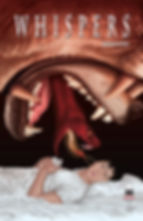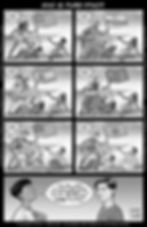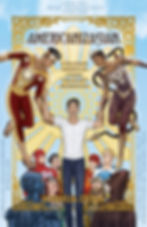Joshua Luna: Opening Conversations Through Comics
- Asela Lee Kemper
- Sep 25, 2020
- 7 min read
Updated: Dec 11, 2020
When it comes to combining social justice with art, Joshua Luna is not afraid to speak up through his comics. Luna is a comic book creator who is best known for works such as ULTRA and GIRLS under the brother team Luna Brothers and his solo series with Image comics, WHISPERS. He has since gained attention for his comics on social media, which explore themes on Filipino American identity in pop culture, history, and Asian communities. He is currently working on his new book AMERICANIZASIAN.
Chopsticks Alley Pinoy caught up with Luna on his career, comics, and experiences in the industry as a Filipino American comic book creator.
Can you share a little background about yourself? How did you get your start in comic books?
Although I was born in California, I spent many of my formative years abroad in places like Iceland and Italy due to my dad being in the Navy. No matter where we lived though, I was always writing and drawing. I returned to Virginia at age 15 and later attended SCAD in Savannah, Georgia, where I turned my passion into a degree, with a major in Sequential Art. I got into the comics industry after graduation and created three series with my brother under the Luna Brothers name (ULTRA, GIRLS, THE SWORD), then a solo series (WHISPERS), and am now currently working on a collection of my online comic strips (AMERICANIZASIAN).

Being Filipino American in the industry, what obstacles did you have to go through and learn from?
I’m fortunate that Hollywood expresses interest in my comic series, but quickly discovered that being a creator of color makes everything harder. When CBS bought the rights to ULTRA and made a TV pilot, they cast Lena Headey as the lead even though Ultra, aka Pearl Penalosa, was Latina. And when THE SWORD was optioned by Lakeshore, I thought my role as a consultant meant I would have a real say in the adaptation of my story, but I never got that opportunity. Over time, I realized that both Hollywood and the comics industry loved my stories and the audiences/success they brought in, but hated my voice—and especially hated it if I dared to view myself as their peer. So when I see white male comic creators enjoying easy publishing resources or have their works adapted to screen and actually get the opportunity to be a writer on those movies/shows, it’s frustrating to say the least.
But the hardest lesson I had to learn wasn’t about industry racism—it was about my own brother. Fil-Ams and other people of color know that we usually have to stick together to combat the effects of institutional racism, but Jonathan took advantage of his role as an elder brother to take more profit and credit for himself, and to even mistreat me at home. It took a long time for me to accept that, and even longer to extract myself and start over as a solo creator.
Who is your inspiration/role model?
Society often teaches us to find inspiration in people who make it to the top, the so-called “big names.” I used to buy into that thinking. But I realized that so many of those people at the top are there because they have no empathy for others and are fine with stepping on others’ backs to get what they want. That’s not the kind of person I admire, so now I find inspiration in the people who fight to remain empathetic and kind even if it means their success takes longer to achieve.
Your work isn’t afraid to tackle darker themes including ULTRA, WHISPERS and THE SWORD. How do you approach these stories?
When people process their trauma, pain, and loss through art, there’s usually one of two directions they take: the first is the super positive route—creating a safe place that’s free from trauma—and the second is digging deeper into that pain. Both are valid, but I tend to gravitate towards the latter because it provides more catharsis for me (at least I hope so!). But overall, when I write, I don’t decide the tone of the story in advance; I let the story take me where it naturally wants to go, which is why I’ve explored multiple genres that combine and overlap (horror, action, superhero, psychological thriller, romance, comedy/parody, etc.).

How is the creation of AMERICANIZASIAN: A Filipino American Comic Creator's Awakening different from your past works (ULTRA, GIRLS, WHISPERS)?
The biggest difference is that AMERICANIZASIAN is rooted in self-love. I’m still proud of my previous works because I did put so much of myself in them, but I never really depicted anyone that close to myself, someone who looked like me or shared my racialized experiences. Like many creators of color, I was taught that “universal themes” meant white.
AMERICANIZASIAN became my way of directly challenging and unpacking that teaching for the first time in my life. And more importantly, it became my way of learning to love myself, and encouraging other Fil-Ams and people of color with the message of self-love.
Last year, you called out Image Comics on Twitter for refusing to publish AMERICANIZASIAN: A Filipino American Comic Creator's Awakening. How much has it changed since posting about your project? For clarity, I’m referring to both Image’s stance and the project itself.
Despite my strips about Fil-Am/Asian American identity and experiences enjoying quite a bit of popularity online—and even being used by educators in classrooms around the world—the partner at Image took huge issue with its content, describing the comics as “angry,” saying the book would have “no story for people to relate to” and should be “more positive,” and suggesting that speaking honestly about Asian American experiences isn't the “right way.” Nothing changed or transpired since I posted about it. Apparently, the Image partner has said everything they wanted to say on the subject.
I’m still working on the book and finding a way to get it into people’s hands, but there has been a lot of setbacks and obstacles—to include the chaos caused by the COVID-19 pandemic. I think it’s been a difficult time for pretty much everyone, but it’s been especially hard for Asians due to the severe anti-Asian racism that’s resulted, which proves that it’s more important than ever to not censor these topics and the Asians who voice them.
Your comics on Twitter have opened conversations on being Asian American and critique on how the East Asian American community views Filipinx Americans. Why did you choose to use your comics to talk about issues such as cultural appropriation and racism?
When I first started making these comics, I took a broad pan-Asian approach. I still speak about and advocate for pan-Asianness, and I always will, but the experiences I’ve had in online spaces in reaction to my comics taught me that East Asian Americans tend to be just as discriminatory against Southeast Asians as East Asians are in Asia. The image of Filipinx as OFW (Overseas Filipino Workers) housekeepers, maids, servants, etc. is so entrenched that even Asian Americans treat us like they expect us to fill the same slot for them.
To this day, I’ve been blacklisted by several prominent East Asian-dominated media outlets for speaking up about hard truths in our community, whether it be about East Asian privilege over non-East Asians, the worship of white-mixed Asians and other patterns of internalized racism, or how some Asian American activists lean on the Model Minority Myth while claiming to dismantle it—such as pushing the idea that only PhDs have the authority to speak about anti-Asian racism. These East Asian-dominated outlets were happy to use me to call out C.B. Cebulski or feature my Mulan essay, but were quick to encourage harassment against me once they felt implicated by my hard truths. It’s worth noting that when I called out Image, not a single East Asian journalist reached out to me, only Southeast and South Asian, and even white too. East Asians typically view themselves as the default Asian American, and that’s why there’s a pattern of them treating me and other vocal Filipinx and Southeast Asians as equals—because if they did, they’d have to share a piece of the pie they’ve been hoarding for themselves.

Because of the lack of Filipinx and Asian American representation in the comic book industry, how do you navigate in a space that lacks inclusivity and tackle stories based on real-life Asian Americans?
Just like in Hollywood, there’s a similar situation in comic spaces where white liberals vocally renounce right wing-leaning creators/content, but don’t acknowledge that they view themselves as white saviors to people of color, which is still a position of superiority. And if you don’t uphold a white-vetted narrative that coddles their white guilt and makes them feel good about themselves, they quietly pull away support. So I’ve been on my own solitary path, creating and writing comics not for the purpose of them being accepted by some industry standard, but meeting my own standards.
How is being a Filipinx American motivating you to continue telling stories in comics?
My goal is to center more Filipinx and other Asians and people of color in my work. I’d also like to advocate for better treatment of Filipinx creators in the comic industry itself, since there’s a history of hiring us only as cheap or exploited labor to prop up white creators and non-Filipinx stories. I’m tired of that. I want to see Filipinx create our own stories and control our own intellectual property, and actually receive the resources and support needed to do that.

What advice do you have for those who are interested in being a comic book creator?
The advice I’d give to any creator—but especially Fil-Ams and other people of color—is: 1. All creative work will be used to send a message, so the question is, what message do you want to send? Who benefits from that message? Your instincts are more preprogrammed than you think, so you must unpack them before you can truly decide. 2. If the door gets shut in your face, build a window. 3. Choose your creative/business partner(s) wisely.

What is next for you?
My next step is to find a new publisher so I can publish AMERICANIZASIAN. I also have a lot more story ideas that I plan on developing into new comic book series—ones I think would really excite a lot of people who have been following my online comics for the past few years—but that’s a little down the road from now. In the meantime, I’ll continue to post comics online and stay in touch with readers.
Where can readers find you and support your work?
If you like stories like this, subscribe to Chopsticks Alley.

Asela L. Kemper
Chopsticks Alley Pinoy Co-Editor
Asela holds a BFA in Creative Writing with a minor in Emerging Media & Digital Arts from Southern Oregon University. She holds many positions including poetry reader for Timberline Review, Borderlands: Texas Poetry Review, Marías at Sampaguitas, Silk Club: QUIET!, Reclamation Mag and No Tender Fences. Asela uses her passion for creative writing to open conversations on diversity and identity in literature, engage and uplift underrepresented Asian American artists. She resides in Oregon, USA with her family.
